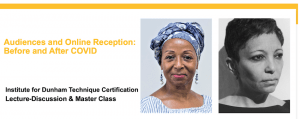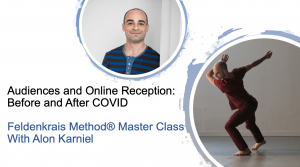
Photo by Elena Benthaus, used with permission. Design by Regina Harlig.
My biggest project pursued under Audiences and Online Reception: Before and After COVID is the issue of The International Journal of Screendance I am guest-editing with OSU alum (2019) and now Assistant Clinical Professor at University of Maryland, Alexandra Harlig, which is forthcoming in May/June https://screendancejournal.org/. We decided to open a space for our contributors to share their work and hosted a symposium on March 12-13 and 19-20 in conjunction with the special issue. We additionally organized some roundtable events on specific topics of interest: TikTok and Short-form Screendance, The Future of Screendance, and Screendance Festivals and Online Audiences. We tweeted under #WhereWeDanceNow and all of the symposium events were recorded and can be viewed online on the symposium website: https://u.osu.edu/thisiswherewedancenow/
The symposium marked what for many of us was a one-year anniversary of living with COVID, quarantines, and lockdowns as part of our new reality. When I proposed the special issue, I was slightly concerned that the pandemic was going to turn out to be a short blip, and that the issue would not feel relevant when it came out. I could not foresee the magnitude of the pandemic, and that the reason for our convening over those two weekends in March would be to grapple with what it means to make and practice dance onscreen in the midst of a virus that, at that point, had claimed over 2.5 million lives globally—a number that has increased to 3.25 as I write this in May 2021.
As with the journal special issue, the symposium considered the impact of COVID on the field of dance—where, how, why, and under what conditions we dance, now, when all dance is screendance. The symposium was on Zoom at no cost to presenters or attendees, and we were blown away by the response: nearly 300 registrants from around the world for the symposium’s 7 events (3 roundtables, 3 paper panels, and a conversation with the IJSD editorial board). As a global community, it is difficult for the screendance field to gather in person, and the burden to travel usually falls to those in the global south. We hope that this symposium was the first of many more to come, and that the new possibilities and infrastructures that arose to support the pivots necessitated by the pandemic will enable us to continue to sustain a globally expanded vision of dance onscreen.


